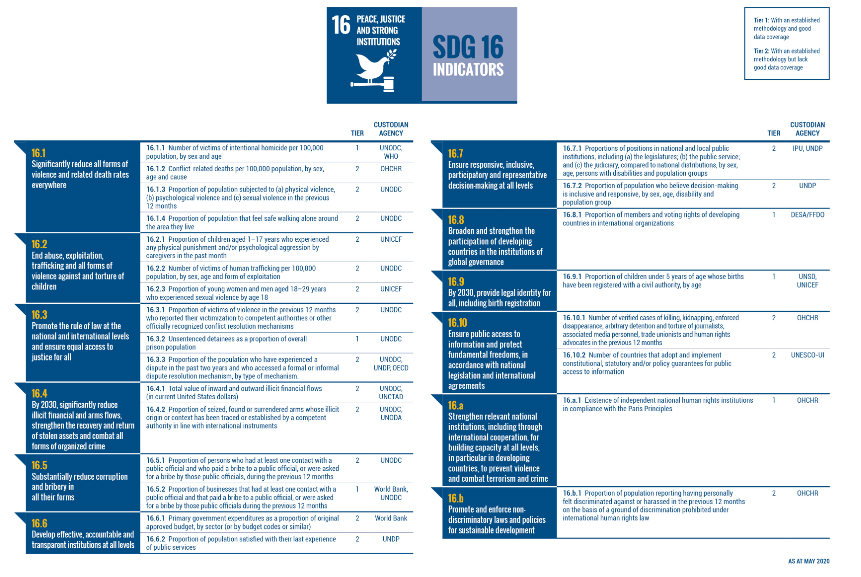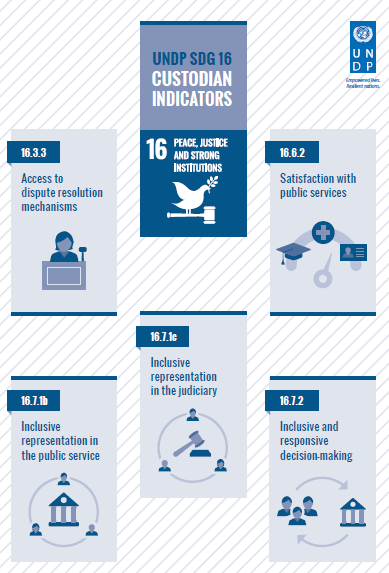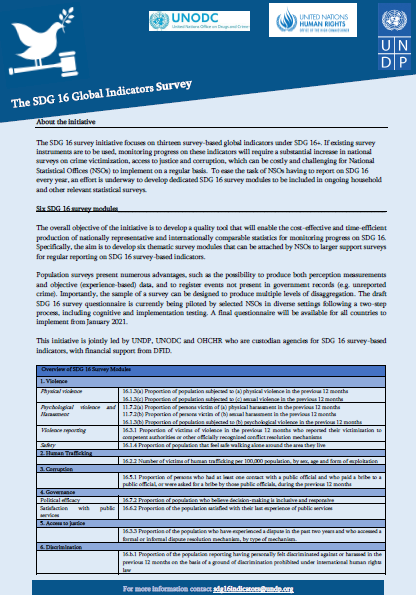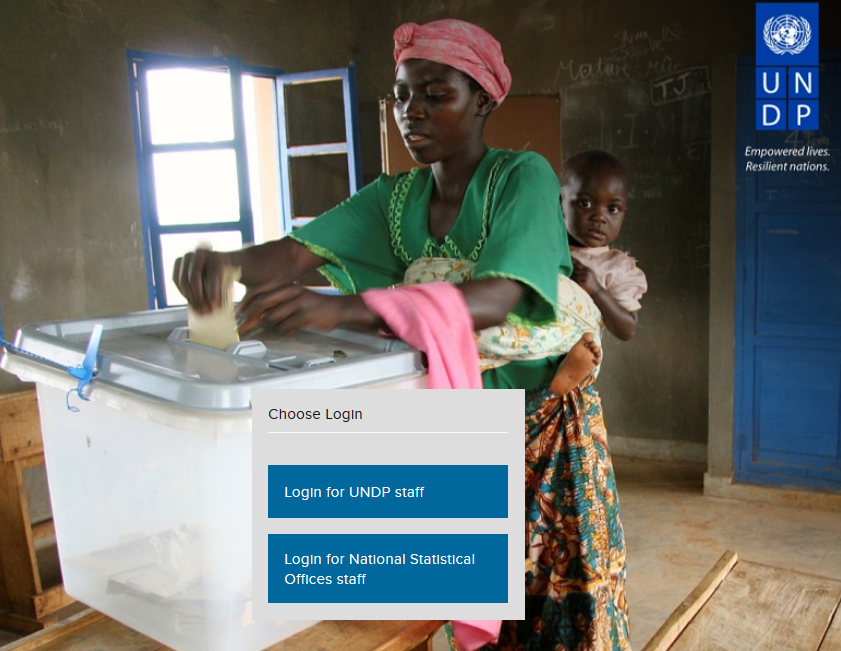UNDP support to reporting on the global SDG 16 indicators under targets 16.3, 16.6 and 16.7
UNDP support to reporting on the global SDG 16 indicators under targets 16.3, 16.6 and 16.7
SDG 16 with its 12 global targets and 23 associated indicators, is considered a foundational goal of the 2030 Agenda, given the importance of governance, peace, security and justice for achieving all other SDGs. The indicators that fall under UNDP custodianship address the core functions of a functioning democratic state built on inclusive, representative and accountable governance structures that are key for development to be sustainable and for sustaining peace.

UNDP is the custodian UN agency for 5 global SDG 16 indicators. In this capacity, UNDP is supporting countries’ efforts in monitoring progress on SDG 16 and the 2030 Agenda. The responsibilities of an SDG indicator custodian agency include the following:
· Contributing to statistical capacity building to enable countries to compile the indicator
· Collecting data from national statistical systems based on the indicator metadata
· Transmitting data points from countries to UN Statistics Division SDG global database

The indicators that fall under UNDP custodianship address the core functions of a functioning democratic state built on inclusive, representative and accountable governance structures that are key for development to be sustainable and for sustaining peace.
Target 16.3: Promote the rule of law at the national and international levels and ensure equal access to justice for all.

SDG indicator 16.3.3: Proportion of the population who have experienced a dispute in the past two years and who accessed a formal or informal dispute resolution mechanism, by type of mechanism.
This indicator measures the number of persons who experienced a dispute during the past two years who accessed a formal or informal dispute resolution mechanism, as a percentage of all those who experienced a dispute in the past two years, by type of mechanism.
Target 16.6: Develop effective, accountable and transparent institutions at all levels

SDG indicator 16.6.2: Proportion of the population satisfied with their last experience of public services, specifically a) healthcare services, b) education services and c) government services.
This indicator measures the population’s experience and satisfaction with public services, through nationally representative household surveys. It focuses on the three service areas of (1) healthcare, (2) education and (3) government services (i.e. services to obtain government-issued identification documents and services for the civil registration of life events such as births, marriages and deaths). Service users are asked to provide their opinion about their last experience with the respective service, both in terms of specific attributes (such as accessibility, affordability, equal treatment for everyone, etc.) and overall satisfaction.
Target 16.7: Ensure responsive, inclusive, participatory and representative decision-making at all levels

SDG indicator 16.7.1 (b): Proportions of positions (by sex, age, persons with disabilities and population groups) in the public service (national and local), compared to national distributions.
This indicator measures the extent to which a country’s public institutions are representative of the general population compared to the national proportions of various demographic groups. The most common and most comprehensive method for collecting public servant data is a Human Resource Management Information System. Such systems have been found to produce the most robust data and to have the greatest potential for expansion on various dimensions of disaggregation.

SDG indicator 16.7.1 (c): Proportions of positions (by sex, age, persons with disabilities and population groups) in the judiciary (national and local), compared to national distributions.
This indicator measures the extent to which a country’s judiciary is representative of the general population compared to the national proportions of various demographic groups. It draws from administrative records on the staffing of the judiciary, typically held by the Human Resource Management Information Systems of a Judicial Services Commission and/or a Ministry of Justice.

SDG indicator 16.7.2: Proportion of population who believe decision-making is inclusive and responsive, by sex, age, disability and population group
This indicator captures the extent to which various socio-demographic parts of the population feel that their views can impact public decision-making processes. It measures the extent to which people believe that politicians and/or political institutions will listen to, and act on, the opinions of ordinary citizens. Data is collected through official, nationally representative household surveys

SDG 16 Survey Instrument – soon available
The SDG 16 Survey Initiative is a joint initiative with UNODC and OHCHR offering ready-made survey modules for National Statistical Systems to produce data for the global survey-based indictors under SDG 16 of which very few countries have data. Population surveys present numerous advantages – including high data quality and the possibility to produce indicators disaggregated by demographic and other variables. The modules can be included by NSOs in on-going household surveys for regular reporting on the SDG 16 indicators and will enable the collection of nationally representative and internationally comparable statistics. The SDG 16 modular questionnaire is currently being piloted in a diversity of country contexts and will be ready for global roll-out in 2020.
Contact sdg16indicators@undp.org for more information.
UNDP’s SDG 16 Data Reporting Platform
To fulfil its responsibility as a custodian agency, UNDP – under the oversight of its Oslo Governance Centre - has established an online SDG 16 Data Reporting Platform to facilitate the process of collecting and quality assuring data submitted by National Statistical Systems on its custodian indicators. Focal points in national statistical offices will soon be invited to upload national data through this user-friendly interface, as well as information on how the data was collected. NSOs will have until November of each year to submit data for a given reporting year.

For more information about this platform, please contact sdg16indicators@undp.org

 Locations
Locations